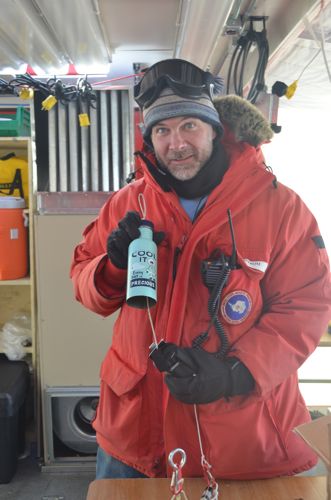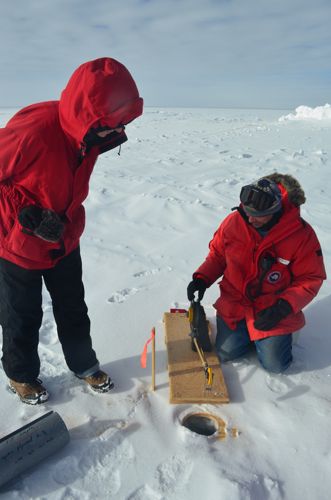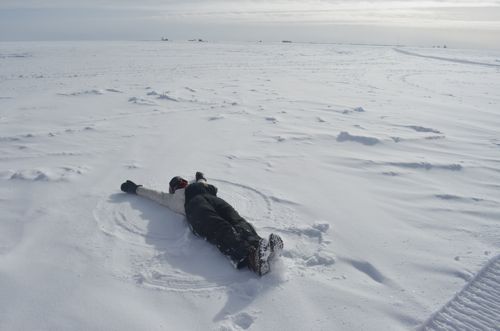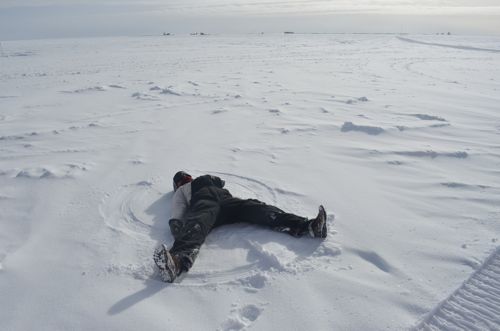Ahh the weekend
Although it was a wonderful holiday weekend, it is time to get back into the swing of things. Here is a video showing some of the holiday festivities I enjoyed:
http://
Close, but no cigar.
Weather is slowly clearing up which means we may get to the AGO in time. Today the AGO team had high hopes to get our cargo out, but the weather wasn't completely clear so the pilots decided to wait a day. Patience is a learned art here. I was warned that I would need to be able to go with the flow and be prepared for delays, but I didn't realize it would be this long of a wait! Luckily I am at an amazing place with plenty to do and see.
Visit to ARA
Yesterday I was invited to return to the Askarayan Radio Array radio antennas. If you remember from the prior journal, ARA is a project that is looking for high-energy neutrinos using radio waves. Darrell Hamilton and Perry Sandstrom were heading out to the antennas and invited two researchers and me to come along. We were picked up in an interesting van!
 The vans here are equipped with tracks to accommodate the snow and ice.
The vans here are equipped with tracks to accommodate the snow and ice.
Filming the drill hole
Perry wanted to go to the ARA site to film the inside of the drill holes, which will eventually hold radio antennas. He designed a tool that could fit into the hole so he could be sure of the size and depth of it. Perry's contraption is home made, but works perfectly! A water bottle protects the camera, which is attached by a string to a flashlight and a weight. The device can travel down the hole without any trouble.
 Perry Sandstrom displays the device he uses to film the depth and width of the drill holes.
Perry Sandstrom displays the device he uses to film the depth and width of the drill holes.
 Perry Sandstrom places his camera carefully down the drill hole while graduate student, Shawn, looks on.
Perry Sandstrom places his camera carefully down the drill hole while graduate student, Shawn, looks on.
The first hole Perry filmed was 160 feet deep. It was a calibration hole. It is called a calibration hole because it will eventually be used to calibrate the radio antennas once they are installed. The team will calibrate the radio antennas by installing pulsars into four holes. The pulsars will emulate the signals the team expects to receive from high-energy neutrinos. The scientists can then tweak their instruments until they record the data correctly. Neutrinos make short pulses when they travel through the ice. The radio instruments will be calibrated using the man-made pulsars so that they can accurately detect the neutrino signals.
 A view of the drill hole with the camera inside it.
A view of the drill hole with the camera inside it.
Drilling holes
ARA is at the beginning of their project, which means they have many holes to drill. The team wants to record neutrinos over a large space. This is because when neutrinos interact with particles in the ice, they create a distinct cone shape over a large area that is different from anything man-made. In order to detect the whole cone shape, the team needs a lot of radio antennas spread over a large space (at least 20 square kilometers).
 A generator creates electricity for the drill equipment.
A generator creates electricity for the drill equipment.
Keeping things powered and heated is important for the ARA drill holes. Darrell explained how the hot water drill system at ARA works. A generator, which runs on fuel, provides electricity for the machinery. Hot water is heated in the red container in the picture below, and is then sent to the drill. Water is pumped at 10 gallons a minute. More hot water is needed than can be held in the red container. To provide enough water, snow gets scooped into an adjacent metal container, which is quickly melted with the hot water. The team tries to keep costs down.
 The red tank at the end heats water for the drill, while the silver tank melts snow to continually provide water.
The red tank at the end heats water for the drill, while the silver tank melts snow to continually provide water.
 Darrell Hamilton stands next to one of the hot water drills used for the ARA project.
Darrell Hamilton stands next to one of the hot water drills used for the ARA project.
When the workers are done for the day, they need to keep the water warm overnight for the next day of drilling. To do this, they pump glycol (antifreeze) through the hot water. This is called "pickling the tank".
 Glycol flows through a tube into the red tank to keep the water from freezing over night.
Glycol flows through a tube into the red tank to keep the water from freezing over night.
Fresh Snow!
Christmas Eve's blustery weather caused a little snow to fall and large snow drifts to form. The amount of snow that drifted in just one day was impressive!
 A bunny boot provides a good scale to show the amount of snow drift that accumulated in one day.
A bunny boot provides a good scale to show the amount of snow drift that accumulated in one day.
Yesterday's warm weather combined with the fresh snow made it a perfect snow angel day! I took advantage of the opportunity.
How to make a snow angel:
- Step 1: Lie on an undisturbed patch of snow with hands out and legs straight.
 Step 1: Stretch out
Step 1: Stretch out
- Step 2: Move arms and legs up and down. Repeat multiple times.
 Step 2: Move your limbs
Step 2: Move your limbs
- Step 3: Carefully stand up and admire your work.
 Step 3: Admire your work.
Step 3: Admire your work.
The Hawaiians
Yesterday's record-breaking temperatures allowed me to tour ARA without a windbreaker or my Big Red coat. However, the attire the Hawaiian scientists who work at ARA did not change; they typically wear shorts around the station!
 Hawaiian scientists frequently wear shorts despite sub-zero temperatures.
Hawaiian scientists frequently wear shorts despite sub-zero temperatures.
Questions
How is the ARA project similar to the IceCube project? How is it different?
Math Connection
If the radio antennas need to fill a 20 by 20 kilometer space, what is the total area of the square?
If the depth of the radio antennas is only about 100 meters, what is the volume of the space? (Hint: watch your units -- you'll need to make a conversion!).
If the hot water drill is pumped at 10 gallons a minute, how many gallons of water is pumped out in an hour?
